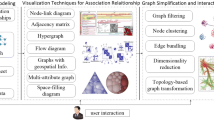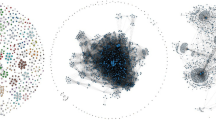Abstract
A combination of node-link diagram and matrix seems to be beneficial since their respective strengths and weaknesses complement each other. However, users have to read both representations in different ways and switch between these representation styles. We conducted a user study to understand how users transform a node-link diagram to a matrix representation and vice versa. For this purpose we let participants draw node-link diagrams and matrices. The drawings were analyzed to identify strategies how user convert one visualization into the other one.
Access this chapter
Tax calculation will be finalised at checkout
Purchases are for personal use only
Similar content being viewed by others
References
Alper, B., Bach, B., Henry Riche, N., Isenberg, T., Fekete, J.D.: Weighted graph comparison techniques for brain connectivity analysis. In: Proceedings of the SIGCHI Conference on Human Factors in Computing Systems. ACM (2013)
Ballweg, K., Pohl, M., Wallner, G., von Landesberger, T.: Visual similarity perception of directed acyclic graphs: a study on influencing factors. In: Frati, F., Ma, K.-L. (eds.) GD 2017. LNCS, vol. 10692, pp. 241–255. Springer, Cham (2018). https://doi.org/10.1007/978-3-319-73915-1_20
Beck, F., Burch, M., Diehl, S., Weiskopf, D.: The state of the art in visualizing dynamic graphs. In: EuroVis State-of-The-Art Report. The Eurographics Association (2014)
Buxton, B.: Sketching User Experiences: Getting the Design Right and the Right Design. Morgan Kaufmann Publishers Inc., Burlington (2007)
Ghoniem, M., Fekete, J.D., Castagliola, P.: A comparison of the readability of graphs using node-link and matrix-based representations. In: Proceedings of the IEEE Symposium on Information Visualization. IEEE (2004)
Henry, N., Fekete, J.D.: MatrixExplorer: a dual-representation system to explore social networks. TVCG 12(5) (2006)
Henry, N., Fekete, J.-D.: MatLink: enhanced matrix visualization for analyzing social networks. In: Baranauskas, C., Palanque, P., Abascal, J., Barbosa, S.D.J. (eds.) INTERACT 2007. LNCS, vol. 4663, pp. 288–302. Springer, Heidelberg (2007). https://doi.org/10.1007/978-3-540-74800-7_24
Henry, N., Fekete, J.D., McGuffin, M.J.: NodeTrix: a hybrid visualization of social networks. TVCG 13(6) (2007)
Keller, R., Eckert, C.M., Clarkson, P.J.: Matrices or node-link diagrams: which visual representation is better for visualising connectivity models? Inf. Vis. 5(1) (2006)
Ko, S., Afzal, S., Walton, S., Yang, Y., Chae, J., Malik, A., Jang, Y., Chen, M., Ebert, D.: Analyzing high-dimensional multivariate network links with integrated anomaly detection, highlighting and exploration. In: Proceedings of the IEEE Conference on Visual Analytics Science and Technology. IEEE (2014)
Liu, X., Shen, H.W.: The effects of representation and juxtaposition on graphical perception of matrix visualization. In: Proceedings of the 33rd Annual ACM Conference on Human Factors in Computing Systems. ACM (2015)
Metzger, W.: Laws of Seeing. The MIT Press, Cambridge (2006)
Purchase, H.C.: Metrics for graph drawing aesthetics. JVLC 13(5) (2002)
Seidler, P., Haider, J., Kodagoda, N., Wong, B.L.W., Pohl, M., Adderley, R.: Design for intelligence analysis of complex systems: evolution of criminal networks. In: Proceedings of the European Intelligence and Security Informatics Conference. IEEE (2016)
Tversky, B., Suwa, M.: Thinking with Sketches. Oxford University Press, Oxford (2009)
Walny, J., Huron, S., Carpendale, S.: An Exploratory Study of Data Sketching for Visual Representation. In: Computer Graphics Forum (2015)
Acknowledgments
This work was supported by CVAST, funded by the Austrian Federal Ministry of Science, Research, and Economy in the exceptional Laura Bassi Centres of Excellence initiative (#822746).
Author information
Authors and Affiliations
Corresponding author
Editor information
Editors and Affiliations
Rights and permissions
Copyright information
© 2018 Springer International Publishing AG, part of Springer Nature
About this paper
Cite this paper
Kriglstein, S., Pohl, M., Doppler Haider, J. (2018). How Users Transform Node-Link Diagrams to Matrices and Vice Versa. In: Chapman, P., Stapleton, G., Moktefi, A., Perez-Kriz, S., Bellucci, F. (eds) Diagrammatic Representation and Inference. Diagrams 2018. Lecture Notes in Computer Science(), vol 10871. Springer, Cham. https://doi.org/10.1007/978-3-319-91376-6_48
Download citation
DOI: https://doi.org/10.1007/978-3-319-91376-6_48
Published:
Publisher Name: Springer, Cham
Print ISBN: 978-3-319-91375-9
Online ISBN: 978-3-319-91376-6
eBook Packages: Computer ScienceComputer Science (R0)




